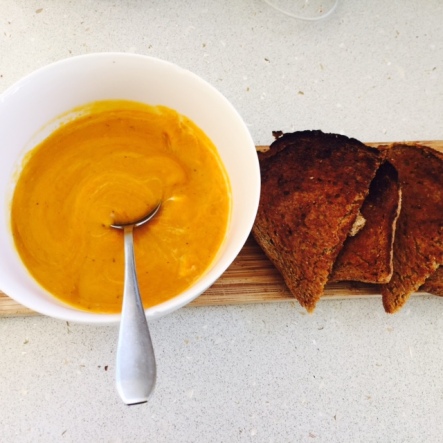Once again this year my pumpkin vines think the whole garden belongs to them. They are slowly taking over everything, the paving, the lawn, all my garden screens. If the dog sits still too long we may lose him too! But I’m okay with this (not the part about the dog of course). As the vines start to reach further and further I am finding more and more female flowers and of course the bees are abuzz (pardon the pun) with all the pollinating! There is nothing better than starting winter with a huge pile of pumpkins waiting to become delicious piping hot soup!

Last year I put in 3 plants and got about 20 pumpkins of varying sizes but this year I have increased to 5 plants so I will let you know at the start of winter how many they produced.
My favourite pumpkin to grow is the Jap. I prefer the flavour of my soup when it’s made with a Jap pumpkin. My sister grows Butternut’s and Queensland Blue’s really well in our Canberra climate too so I think that most varieties will do well here. Just remember to keep the water up to them if the summer is particularly hot as it has been recently. During the heat wave where temps were reaching as hot as 41 degrees C (105.8 F) the leaves looked like they had given up all hope but a good soaking in the evening once the sun starting to go down brought them right back to life.
I like to put a little piece of timber or a brick under the fruit as it’s growing to prevent any rotting from wet ground as the season changes.
I’m always nervous about picking my pumpkins in case they are not quite ready. But a few tips to make sure they are include:
• Give the pumpkin a good thump or a slap. If the pumpkin sounds hollow it’s ready.
• The skin of a pumpkin will be hard when the pumpkin is ripe. Try to puncture the pumpkin’s skin with your fingernail (gently). If the skin dents but doesn’t puncture, it’s ready.
• When the stem above the pumpkin in question starts to turn hard, the pumpkin is ready.
You can tell which flowers are female, the ones destined to become a fruit, by the little bulge under the flower. As the flower grows and opens it is visibly different to the male flower. The female flower is closer to the vine than the male flower and the stem will only be a few centimetres long, at most. It also has a multi segmented stigma. This stigma must be pollinated in order for the fruit to develop. Male flowers on the other hand grow on a longer thin stem with a centre stamen that contains the pollen. Its fun to watch the bees go in a get completely covered in pollen. They come out looking pollen drunk!
Happy Gardening!



